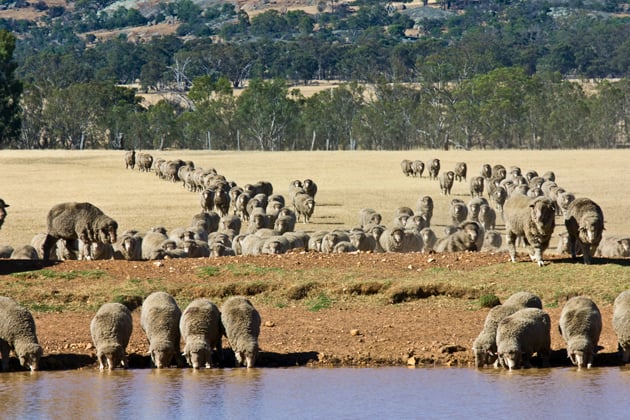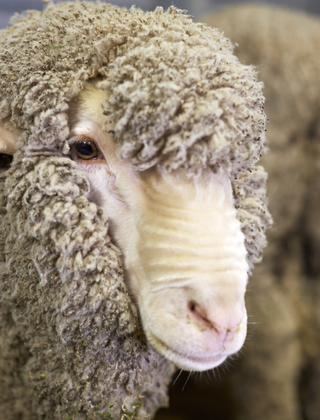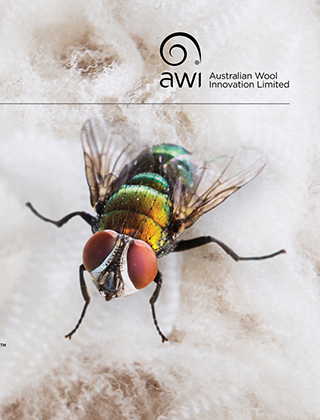How to prepare for the effects of El Niño

After a few years of good seasonal conditions across much of Australia, an El Niño climate pattern has been declared and drier weather has arrived. What can woolgrowers do to prepare for potentially warm and dry conditions to ensure the health of their sheep? Here Animal Health Australia provides some tips.
The Bureau of Meteorology officially declared in September that an El Niño event is currently underway for Australia. During El Niño, there is a higher chance of reduced rainfall for eastern Australia, warmer daytime temperatures for the southern two-thirds of Australia, increased risk of extreme heat, and increased bushfire danger in south-eastern Australia.
No two El Niño episodes, or their impacts upon Australia, are identical. El Niño events do not always guarantee a drought will take place. Winter and spring rainfall are typically the most severely impacted.
The Bureau of Meteorology has also declared that a positive Indian Ocean Dipole (IOD) is underway. When a positive IOD and El Niño occur together, their drying effect is typically stronger and more widespread across Australia. Some areas of Australia already have drier than usual conditions.
The latest seasonal forecast provided by the Bureau, for December through to March, predicts below median rainfall for many wool-growing regions, as well as unusually warm temperatures for most of Australia. Woolgrowers should keep a regular watch on the Bureau’s long-range forecasts and climate drivers, which are regularly updated and are available at http://www.bom.gov.au/climate/ahead/.
Management practices to consider
Dry seasonal conditions need to be planned for, and carefully managed if they eventuate. Woolgrowers can consider options such as:
- Reducing grazing pressure on their pastures by selling or agisting stock. If a drought were to occur, agistment options will become limited and more expensive.
- Prepare for the possible requirement of stock containment areas. The main purpose for using these is to preserve soil and pasture quality during dry times, as well as to better monitor animal health and feed intake. Containment feeding may also be a requirement, therefore producers should consider the biosecurity risks associated with bringing purchased feed and fodder onto the property, and check for signs of pests (for example, mouse droppings) and weed seeds, such as annual ryegrass.
- Provide adequate shade and shelter to keep your animals comfortable and prevent heat stress in extreme conditions. Shade will also reduce the water requirements of the flock in hot weather. Some considerations for shade include:
-
- Temporary or construction shade structures that can be made from materials such as shade cloth and corrugated iron.
- Large shade trees and shelter belts are permanent solutions.
- Consider the likelihood of sheep crowding the shelters and plan accordingly.
- Have a drought plan in place
Actions such as these should be considered in terms of all other aspects of the farming operation and within the long-term plan for the farm.
Biosecurity considerations
Parasite management
The recent La Niña periods of higher-than-average rainfall saw favourable conditions for parasites and diseases such as liver fluke, flystrike, virulent footrot, and barber’s pole worm. If dry conditions continue to worsen, then sheep may also be more susceptible to parasites due to impaired immunity (from poor nutrition and/or drought-related stress), and increasingly crowded conditions around shade, feed, and water sources.
Parasite management practices such as faecal worm egg counts and strategic drenching should be prioritised, even when the overall pasture parasite loads are reduced due to the dry weather. See pages 16-17 for how dry times affect worms. More information on the seasonal management of parasites affecting sheep can be found on ParaBoss (www.paraboss.com.au).
Disease management
Dwindling water sources can also lead to an increase in competition for water among wild and feral animals, bringing them into closer proximity with sheep and increasing the chance of disease transmission. Take the time now to check your fencing and consider management controls to safeguard your water sources and your sheep from unwanted contact with wild and feral animals.
If your sheep require supplementary feeding, remember to abide by the ruminant feed ban by not feeding anything containing Restricted Animal Material (RAM) to ruminants. Always check for the RAM statement when purchasing commercial feed.
Pneumonia is another condition to be aware of and can occur in sheep of all ages throughout the year; however, summer pneumonia is frequently seen in weaners. While this condition is caused by a mixture of host, environmental and pathogen factors, dry and dusty conditions are a common causative agent. To reduce the risk of pneumonia in your flock, implement dust reduction strategies during your day-to-day husbandry practices. Examples include effective pasture management, mustering slowly and during cooler parts of the day, hosing down yards and avoiding the use of dusty feed.
Stress management is also crucial at this time, as lambs are particularly susceptible to disease during the stressful time of weaning.
Dry and dusty conditions also pose an increased risk of Q fever, a zoonotic disease spread to humans by a range of animals including sheep. Ensure that all staff, particularly new workers, are vaccinated against Q fever when working with livestock.
More information:
- Bureau of Meteorology long range forecasts and climate drivers: http://www.bom.gov.au/climate/ahead/
- Farm Biosecurity website: www.farmbiosecurity.com.au
Resources for dry seasonal conditions
AWI provides a range of resources to help woolgrowers plan and carefully manage their enterprises in the lead up to and during dry seasonal conditions, including:
Publications:
- Feeding and managing sheep in dry times
This publication provides producers with practical guidelines and examples on feeding and managing sheep during dry seasons and drought years. While it focuses on dry times and confinement feeding systems, it also has useful information on getting through the normal summer/autumn feed gap period.
- Managing sheep in droughtlots
A best-practice guide that highlights the purpose, benefits and experiences of woolgrowers managing sheep in confined areas during drought.
- Stock water – a limited resource
A fact sheet that helps calculate stock water budgets, especially when droughtlotting sheep.
- Managing fodder prices for droughts
A guide to strategies that help manage fodder prices and supply risks during droughts.
- Which sheep do I keep?
A guide to help determine whether to sell or supplementary-feed all, some or none of the flock.
- Drought feeding and management of sheep (Agriculture Victoria)
A practical guide on sheep feeding and management during a drought to help producers break down into manageable steps the daunting planning phase, and see the plan realised as a successful way of combating the drought.
Decision support tools:
- Cost of production calculator
Cost of production (COP) is a key factor affecting the profitability of wool producing businesses. COP, measured in dollars per kilogram of clean wool, is an indication of the outlay required to produce each kilogram of wool.
- LifetimeWool feed budget tables
Feed budgeting for ewe flocks in the dry season.
- Feed On Offer library
The Feed On Offer (FOO) library allows users to estimate FOO and nutritive value of grazed pastures.
More information: These and other AWI and state/national drought resources are available at www.wool.com/drought
Livestock safety during bushfires
AWI also provides a range of information to help woolgrowers with bushfire preparation and recovery. See www.wool.com/bushfires
This article appeared in the December 2023 edition of AWI’s Beyond the Bale magazine. Reproduction of the article is encouraged.














